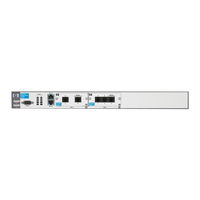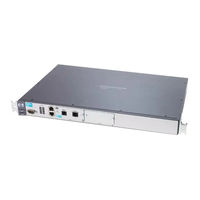HP J8752A Manuals
Manuals and User Guides for HP J8752A. We have 2 HP J8752A manuals available for free PDF download: Basic Management And Configuration Manual, Product End-Of-Life Disassembly Instructions
HP J8752A Basic Management And Configuration Manual (910 pages)
ProCurve 7000dl Series Secure Router
Brand: HP
|
Category: Network Router
|
Size: 8.46 MB
Table of Contents
-
1 Overview
33-
Contents
33 -
-
Console Port46
-
Slots47
-
Status Leds55
-
Fault LED55
-
Power LED55
-
Status Leds56
-
Backup Leds57
-
Slot 3 Leds57
-
Activity LED58
-
Status LED58
-
Test LED58
-
Link Leds59
-
Rear Panel59
-
Memory61
-
-
-
Basic Mode68
-
Enable Mode68
-
Clear71
-
Enable71
-
Logout72
-
Ping72
-
Show73
-
Telnet74
-
Traceroute74
-
Terminal75
-
Wall75
-
Clear76
-
Clock77
-
Configure78
-
Copy78
-
Debug81
-
Dir81
-
Disable82
-
Erase82
-
Events83
-
Reload83
-
Show83
-
Undebug89
-
Write89
-
Show Tech90
-
Safemode94
-
Help Tools97
-
Exit99
-
Compact Flash103
-
Troubleshooting103
-
Quick Start121
-
-
-
Contents125
-
-
-
-
SNMP Versions169
-
Quick Start191
-
Enabling AAA195
-
-
-
Contents203
-
-
Setting the MTU214
-
Quick Start229
-
-
-
Contents231
-
-
-
Channels243
-
Line Coding245
-
Frame Format246
-
-
No Light263
-
Red Light263
-
Yellow Light265
-
Green Light266
-
-
Quick Start269
-
-
-
Contents273
-
-
Quick Start295
-
-
-
Contents297
-
-
PPP Overview300
-
Dlci 16318
-
Set the CIR331
-
Set the EIR331
-
Example Networks344
-
-
Frame Relay370
-
Hdlc372
-
Contents375
-
ADSL Overview
378 -
-
Pppoe Overview
403 -
Pppoa Overview
410 -
-
Quick Start429
-
-
Configure RBE433
-
Configure Pppoe434
-
Configure Pppoa436
-
Contents439
-
The Local Loop443
-
-
Lapd448
-
-
Q.931449
-
Call Process449
-
-
-
Commands Work473
-
-
-
-
-
Test Calls513
-
Line Maintenance515
-
-
Quick Start517
-
Contents525
-
-
-
-
-
Yellow Alarm537
-
-
Yellow Alarm546
-
Quick Start547
-
-
-
Overview
555 -
-
STP Bpdus564
-
Overview564
-
STP States565
-
-
Configuring RSTP569
-
Configuring STP575
-
IP Addressing587
-
Networks588
-
Cidr590
-
Routing Table591
-
Load Sharing595
-
Fast Caching596
-
-
-
Host Tables619
-
Overview619
-
DNS Queries620
-
-
Dynamic DNS622
-
Custom DNS623
-
Static DNS623
-
-
Configuring DNS
624 -
-
Process627
-
Quick Start635
-
Router Interface636
-
Contents639
-
-
-
Overview641
-
DHCP Relay644
-
-
-
Function
685-
Configuration687
-
Firmware690
-
Debug693
-
Reboot Unit698
-
Telnet to Unit698
-
-
FTP Access705
-
-
SNMP Settings720
-
IP Settings725
-
Dynamic DNS726
-
Dynamic DNS730
-
Interfaces740
-
IP Settings742
-
Dynamic DNS743
-
Dynamic DNS754
-
IP Settings754
-
Dynamic DNS765
-
Resource Pool778
-
Bridging786
-
Interfaces793
-
Routing795
-
DNS Services799
Advertisement
HP J8752A Product End-Of-Life Disassembly Instructions (2 pages)
Brand: HP
|
Category: Network Router
|
Size: 0.04 MB

